Strictly speaking, The Great Wall of China isn’t a single wall. It’s a complex network of walls, barracks, watch-towers, and other fortifications, and construction on early versions of it might’ve begun more than 2500 years ago. Each of these successive works was, for its time, an astonishing feat of engineering—even if none of them were ever, as the myth goes, visible from space. All of them shared a common purpose, which was to help defend the northern states of China against invasions from various peoples of the Eurasian steppes in and around what is today Mongolia.
This is not quite the story told by Zhang Yimou’s 2016 film The Great Wall, starring Matt Damon, Jing Tian, Pedro Pascal, and Andy Lau—most especially because the real Great Wall has nothing to do with a meteor and rage-fueled lizard dogs from space.
Anyway, let me first say that from a visual perspective this movie can be gorgeous. And, perhaps not surprisingly, the best parts of the film are the set pieces that have become a kind of hallmark of Chinese historical epics. Bright colors. Whipping banners. Waves of extras in perfect choreography. Tracking shots of slow-spinning bolts hurtling through the air. Armed women launching themselves down into the chaos with balletic grace. A squad of gloriously uniformed signal drummers who relay orders in perfect rhythm by playing the drums with nunchucks…because why the hell not, that’s why.
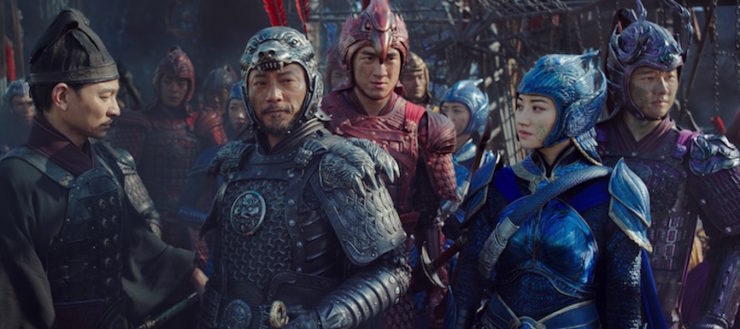
It’s also got a dynamite soundtrack (Ramin Djawadi, whose work you probably know from HBO’s Game of Thrones), and several of the Chinese actors—in particular Jing Tian as Commander Lin Mae and Andy Lau as Strategist Wang—work hard to do something with their roles.
Unfortunately, a lot of the rest of the film doesn’t really work. The story isn’t much of one. Character development is pretty much nil. Plot “twists” are consistently telegraphed way ahead of time. And many of the coolest moments are pretty much stolen from other films: from Tangled’s lanterns in the sky, to the rage-fueled lizard dogs—called the Tao Tei in the film—trying to dog-pile-climb up the Great Wall’s face in World War Z zombie style. (It’s surely not a coincidence that Max Brooks, author of World War Z, is among the story writers in the credits.) Worse, I think, Matt Damon seems to walk through too many of his scenes, and he unsuccessfully tries to pull off some kind of accent that seriously doesn’t work. (I think he was going for Scottish, but it was so in-and-out I couldn’t tell for sure.)
And then there’s the history.
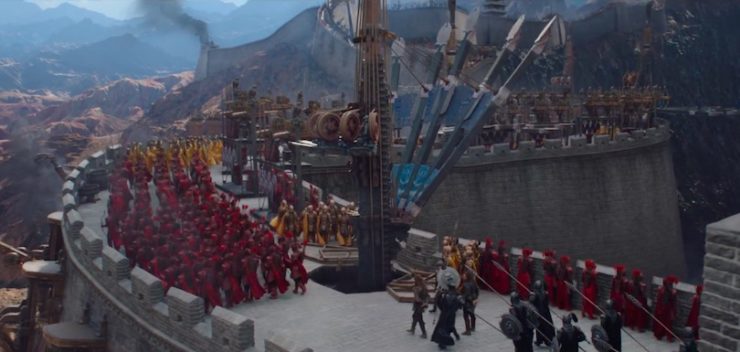
Oddly, when it comes to the history, I was bothered less by the idea of the angry dino-doggies than I was by the various other historical cock-ups in the film. Apparently, I can accept the fantasy of the Great Wall being built to keep out monsters, but I draw the line at the Great Wall hydraulically lifting itself to expose spinning razor blades. I’ve got my own impassable walls, y’all.
One of my biggest issues is the fact that this movie is clearly set upon the Great Wall as we picture it today: an undulating ribbon of stone that flows along crisp ridge-lines. Wide enough for riders, punctuated by square towers whose banners float in the breeze, this Great Wall is visibly and militarily magnificent, and most of it was constructed during the Ming Dynasty (1368-1644).
The movie, though, makes clear that it is set around the year 1100, during the early parts of the Song Dynasty (960-1279). Why did they set it so early? I guess because the excuse for getting Matt Damon’s British-ish character William and Pedro Pascal’s Spaniard Tovar over to China is that they’re mercenaries trying to steal the secret of black powder. That’s an admittedly cool idea … except that since no one in Europe knew about black powder at the time, no one would be trying to steal it like this. (Also, the kind of explosive power William and his pals want wasn’t really in use until about a century later, but I’m willing to give the film a pass for that.)
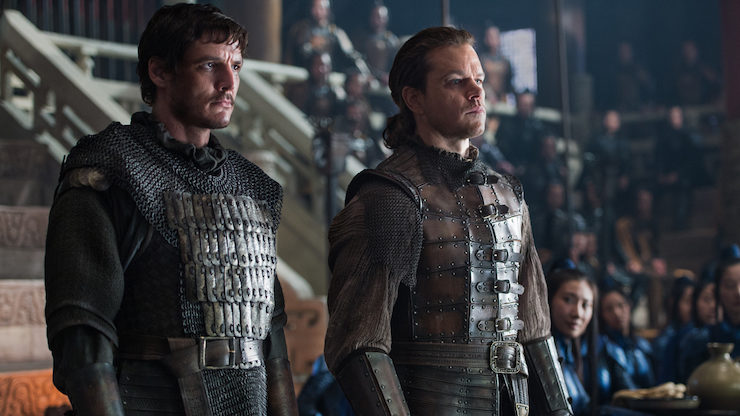
There’s a long list of other little errors, of course, like Damon wearing his armor wrong, metallurgy being capable of making weapons far fancier than would have been possible, or the complete hilarity of William snapping apart a Chinese crossbow to make himself a badass bow. (Because as a medieval Englishman of course he’s like the world’s greatest archer.)
Let me highlight just one of these historical issues, though: the magnetic lodestone that is a major plot point.
I’m going to focus on this one since it gets at two of the Big Issues that folks were worried about when this movie was originally announced: whitewashing and white savioring. These concerns ought to have been expected by the film-makers: the trailers heavily featured a white dude in medieval China, after all, and as a result they certainly lent themselves to a reading of Damon as the white savior who must save the Chinese.
On the worry of whitewashing, I can assure you that the movie isn’t as bad in this regard as it might have looked from the ads and commercials. The purpose of Damon’s character within the plot is most essentially to be that of an outsider. No matter his own abilities, he’s in this movie first and foremost to look on in amazement at the wonder of the Great Wall and the Chinese forces. For that very reason, his role is not one that could have been readily filled by a Chinese actor. No whitewashing here.
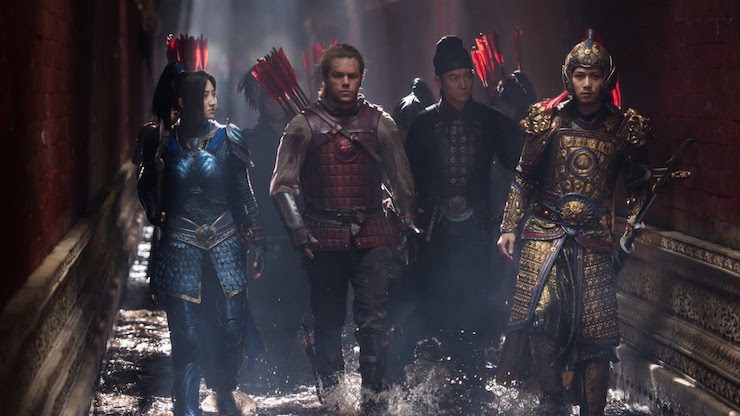
Things are more complicated, though, when it comes to the worry that this was going to be a white savior narrative. On the one hand, yeah, Damon’s William does some heroic things, but he’s also pretty consistently overshadowed by Jing Tang’s Commander Lin. So that’s mostly okay, I guess. On the other hand, suggesting that the medieval Chinese don’t understand lodestones and so they only have the one that Western White William has brought them is…well, it’s insultingly the complete reverse of reality. The Chinese were studying magnetic stones as early as the Han Dynasty, around a 1000 years before Damon’s character was a glint in his mama’s eye. By the time of the Song Dynasty—the setting of the film, you remember—Chinese navigators were making regular use of the compass, a technology that wouldn’t show up in White William’s West until around the 13th century. The Chinese knew lodestones, folks. They had them all over the place. They even wrote about them repeatedly, as in the nearly 2,000-year-old work Lunheng (論衡), which includes the line “a lodestone attracts a needle.”
So, yeah, the idea that the Chinese need Damon’s stone to defend their Great Wall from the Tao Tei is, well, pretty straight-up white savior ridiculousness. And not only did the writers do a disservice to Chinese history on this point, but they actually missed an opportunity to do something pretty cool with it. That line I quoted from the Lunheng, after all, is in a section entitled “A Last Word on Dragons“.
I’m not kidding.
As for my last word on this particular dragon, I wanted to point out that—raging eyes-in-shoulders reptilian Cujos aside—there’s a lot of scholarly debate not just about the effectiveness of border walls in general, but also about the Great Wall in particular. The various incarnations of the Great Wall were certainly effective enough to have been built and rebuilt over the centuries. On the other hand, a map of the various walls shows the volatility of the border—the walls were quite rarely built in the same place—and the fact that they were hardly a fully contiguous line. Plus, the history of northern China includes more than a few successful invasions that went over or around the Great Wall.
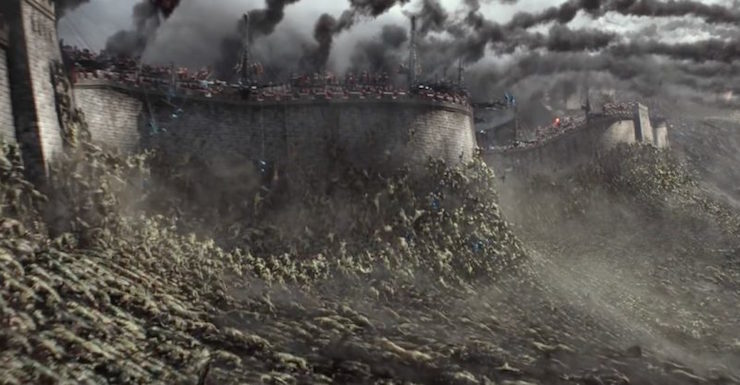
As I once heard a student say, people were bound to figure out how to build ladders.
In seriousness, the Great Wall seems to have functioned quite suitably as what we might call a day-to-day deterrent. It kept small raiding parties at bay. Concerted attempts to get past it, on the other hand, could be successful, as they were on the part of the Mongols and Manchus. Whether that makes the Great Wall an effective use of the resources that were put into its construction—including the oft-reported figure of a half-a-million forced laborers buried in its works—is a matter that’s over my pay-grade.
For those interested in reading more about these aspects of the real Great Wall of China, though, you’d do well to check out Stephen Turnbull’s excellent 2007 study, The Great Wall of China.
 Michael Livingston is a Professor of Medieval Literature at The Citadel who has written extensively both on medieval history and on modern medievalism. His historical fantasy series set in Ancient Rome, The Shards of Heaven and its sequel The Gates of Hell, is available from Tor Books.
Michael Livingston is a Professor of Medieval Literature at The Citadel who has written extensively both on medieval history and on modern medievalism. His historical fantasy series set in Ancient Rome, The Shards of Heaven and its sequel The Gates of Hell, is available from Tor Books.










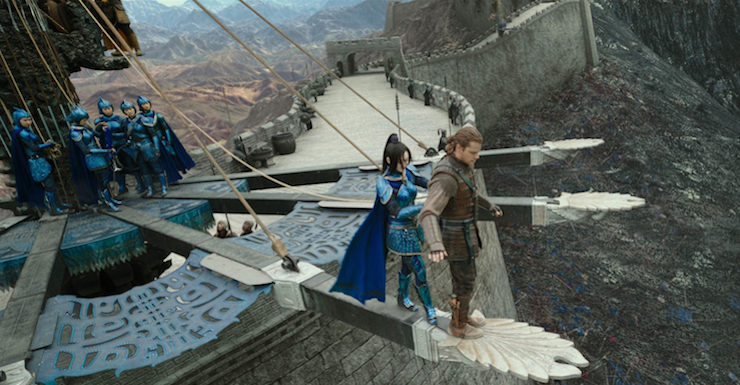
I confess that the plausibility wall I’d die on is the implied population ecology of the Tao Tei. I’ll buy a cyclic massive hatching(?) and locust-style swarming migration, but they still have to eat something in appropriate proportions to grow to adulthood, and they appear to be obligate carnivores…
What I learned in my Frontiers in World History course in college was that the Great Wall was never really effective at keeping people from moving across it in either direction; it was more just a way of defining the border between China and the steppes beyond, and the border between their cultures. Far from being an impermeable barrier between the Chinese and the steppe nomads, it was the nexus of contact and interaction between them, of commerce and cultural exchange. For all that the two cultures’ respective propaganda painted them as intractable enemies, they had a highly interdependent relationship. Trade across the border was commonplace and lucrative, and the government wanted to structure and supervise that trade, to make sure they got their cut of the profits. So the Wall was there to regulate that trade and make sure it happened under the watchful eye of the state.
Moreover, though, the Great Wall in its various forms has been a mythical symbol of state power and/or Chinese identity on and off for thousands of years, and it’s arguably had more impact as a symbol than as a functional object.
I’d like to point out that the “Great Zombie Dogpile” was absent from the original book version of World War Z, and that Max Brooks did not contribute to the screenplay or story of the film beyond what they borrowed from his book.
Ever since my one visit to the Great Wall, involving a frankly terrifying ascent in a four person gondola (during which I lied to myself copiously, and kept repeating, “Not maintained by disgruntled worker in a Communist Regime, NOT maintained by disgruntled worker in a Communist Regime!”) and subsequent trek along it culminating in a climb up an especially steep section that I have forever after referred to as “The Stairway of Trying Not To Yack Up My Liver All Over Manchuria”, I have thought of the Great Wall as a PRACTICAL JOKE.
After scaling 3000 or so feet of ridiculously steep, thornbush encrusted scree-piles, your hypothetical invader/raider/Mongol on a tourist visa looks up and sees…a twenty foot tall wall. That’s not a fortification, that’s prominently displaying a rigidly extended middle finger statue aimed right at a neighbor you’re not fond of. It is the Chinese equivalent of putting Ex Lax in someones chocolate mousse.
It is a massive, publicly funded Whoopie Cushion aimed north…
Until I watched this movie I had no idea that there was a Bungee-Jousting hole in my life.
@5 Lindsay Well, now you’ve made me want to go see this. Having only seen banner ads on the web, and not the trailer, I was expecting this to be in the vein of The Last Samurai, but this sounds kind of fun. Just as long as the hot babe doesn’t throw over her alpha dog boyfriend in favour of misunderstood loner, Matt Damon.
I look at the picture of all the actors in their color armor and just think “Shardplate!” So maybe the production company that does Brandon Sanderson’s Stormlight Archive will be able to borrow set pieces from this movie.
Thank you Michael. I might see this movie now. I really only saw the adds and did not like the white savior implications. But I did see an interview from Matt Damon. Apparently he was asked to play the role because Chinese audiences love him.
I have to admit I was somewhat pleasantly surprised by this movie. I expected godawful, and found suprisingly entertaining absurdity.
I mean sure, it was terrible, but that classic overly-earnest Big Chinese Epic terrible. I pretty much agree with the post in all respects – I mean really, what is the point of bungee jumping lancers on a scale basis other than rule of cool?
Matt Damon gets to be the audience surrogate for a lot of it, and makes for a suitable Western Barbarian, el spanish guy gets to be a sidekick, and the Chinese Girl gets to be a Big Damn Hero.
Huzzah!
The magic lanterns were still a blatantly awful idea, but at least many of them demonstrated the fundamental flaws of their technology. The magic wind that took them to the city in time was rather convenient too.
cue the angry War Drums, subwoofers ahoy!
damn, this series is good. Thanks, as always, for writing it!
It seemed to me that the lodestone was not unknown to the Chinese in the film, just that they didn’t know it had effect on the monsters. What I would have liked to see is, after the connection is made, that they pull out a bunch of lodestones they have on hand and start wielding them all over the battlefield.